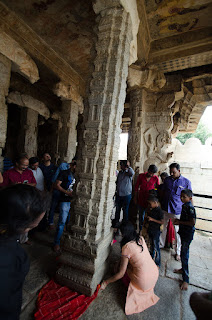The Fascinating Mystery of the Hanging Pillar of Lepakshi Temple
The Lepakshi Temple in Andhra Pradesh, India is a spectacular example of ancient Indian architecture.
The temple is a treasure trove of intricate carvings, sculptures, and paintings. However, what makes this temple truly remarkable is its hanging pillar.
The temple has a pillar that hangs from the ceiling and does not touch the ground. This feat of engineering has puzzled scientists, archaeologists, and visitors alike for centuries. In this article, we will explore the fascinating mystery of the hanging pillar of Lepakshi Temple.
The Hanging Pillar
The Lepakshi Temple was built in the 16th century during the Vijayanagara Empire. The temple is dedicated to Lord Veerabhadra, a fierce form of Lord Shiva. The hanging pillar is located in the main hall of the temple, also known as the Natya Mandapam.
The hanging pillar is about 4.5 meters in height and has a circumference of 2.4 meters. The pillar is made of black granite and is intricately carved with images of gods and goddesses. The pillar is attached to the ceiling with a series of interlocking joints, and it hangs about an inch above the ground. Visitors can pass a cloth or a piece of paper underneath the pillar, which proves that the pillar is indeed hanging.
The Mystery of the Hanging Pillar
The hanging pillar in lepakshi temple has been a mystery for centuries. Many visitors have tried to push or pull the pillar to see if it will move, but it remains firmly in place. The mystery has led to many theories about how the pillar was constructed.
One theory suggests that the pillar was suspended using a magnetic force. Another theory suggests that the pillar was constructed using a combination of metals that allowed it to hang in mid-air. However, neither of these theories has been proven, and the mystery of the hanging pillar remains unsolved.
The Engineering Marvel of the Lepakshi Temple
The hanging pillar is not the only engineering marvel of the Lepakshi Temple. The temple has many other features that showcase the skill of the craftsmen who built it. The temple has a huge Nandi Bull statue, which is the largest monolithic Nandi statue in India. The statue is 27 feet long and 15 feet tall.
The temple also has a massive granite slab that measures 42 feet by 22 feet. The slab is known as the Veerabhadra slab and is located in the temple courtyard. The slab is intricately carved with images of gods, goddesses, and mythical creatures.
The Importance of Lepakshi Temple
The Lepakshi Temple is not just an architectural wonder; it is also an important cultural landmark. The temple is a testament to the rich cultural heritage of India and showcases the skill and craftsmanship of the artisans who built it.
The temple attracts visitors from all over the world, who come to marvel at its beauty and to learn about its history. The hanging pillar, in particular, is a major attraction for visitors, who are fascinated by its mystery and its engineering.
Conclusion
The hanging pillar of Lepakshi Temple is a fascinating mystery that has puzzled scientists and visitors alike for centuries. The temple is an architectural marvel that showcases the skill and craftsmanship of ancient Indian artisans. The temple is an important cultural landmark that attracts visitors from all over the world. The mystery of the hanging pillar may never be solved, but it will continue to intrigue and fascinate visitors for generations to come.
Read More
lepakshi temple hanging pillar reason
lepakshi temple hanging pillar
hanging pillar of lepakshi secret
lepakshi temple hanging pillar in hindi
how many hanging pillars are there in lepakshi temple
floating pillar temple in india




Comments
Post a Comment